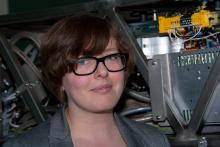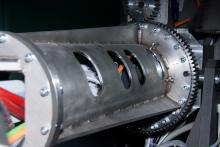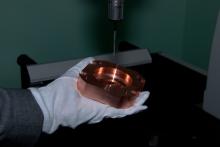Objective of the project realized by NCBJ physicists, WCO physicians & medical physicists together with some industrial partners (UJP Hitec Systems S.A., Jarosław Kołcun) is to develop a state-of-the-art device that would meet needs of clinical oncologists as much as possible.
„NCBJ experts’ know-how on medical accelerators will be combined in the INTRA-DOSE project with expertise of WCO physicians & medical physicists on oncology clinic real environment and with their practical experience. A tight cooperation with medical community is crucial to correctly and precisely specify functionalities of individual subassemblies of the system, and in effect to develop equipment that would best match real needs of its users in clinics. Collaboration with entrepreneurs is equally important for success of the project. Reliable evaluation of cost-effectiveness of various technically possible solutions already at the subassembly designing stage is a pre-condition to quickly and effectively implement project outcomes as soon as it is finished.” – said Eng. Kaja Swat MSc, Deputy Head of the INTRA-DOSE project.
System components to be optimized during R&D works to be conducted within the project include accelerating structures, mechanical construction, electronic circuits, and arm movement control systems. Intuitive control system, therapy planning software, and an audio-visual system will also be developed. Therapeutic beam should feature high dose rates (total doses 10-15 Gy) and a wide electron energy range (4 to 12 MeV). Various applicators that will optimally match therapy field to each treated clinical case will also be developed.
„We hope that unique advantages of the device under construction will give it a competitive edge against other market competitors” – said MSc Sebastian Adamczyk, medical physicists from WCO – „We are convinced that experience gathered by us during many years of applying intra-operative radiotherapy combined with Świerk researchers R&D potential will allow us to develop Polish equipment capable to successfully compete on international markets”.
Four already submitted patent claims (including a claim for a method and a device to shape electron beams in mobile medical accelerators) show how innovative the new system will be. New innovative solutions are under development and next claims may be expected.
The INTRA-DOSE project is a continuation of efforts spent on development of accelerator technologies within framework of the “Development of Dedicated Systems Based on Accelerators and Detectors of Ionizing Radiation for Medical Therapy and in Detection of Hazardous Materials and Toxic Wastes” (AiD) project accomplished in NCBJ in years 2008-2014.
„Works completed within the AiD project framework gave us know-how indispensable to construct a system for intra-operative radiotherapy. The INTRA-DOSE project started on January 1, 2014 as a continuation of works on INTRALINE, the first model of a medical accelerator for intra-operative therapy” – informed Dr. Agnieszka Syntfeld-Każuch, Head of the INTRA-DOSE project. – „Our so-far obtained scientific results combined with experience of physicians should improve perception of Polish Hi-Tech products in ever more innovation-driven world”.
Electron beam-based intra-operative radiotherapy offers several advantages in comparison with post-operative radiotherapy. The advantages that translate into an increased cure rate in cancer patients include: capability to visually inspect the procedure to shape the to-be-irradiated field, increased vulnerability of exposed tissues to radiation, capability to apply a higher dose in a single session since there are better opportunities to save surrounding healthy tissues and/or critical organs. Improvements in therapeutic effects are accompanied by reduction of adverse side effects of radiation on patient’s skin (skin burning in severe cases), which is an additional benefit from the cosmetic point of view.
„Electron beam-based intra-operative radiotherapy is among the most modern methods used to treat patients with oncological disorder. The method may be applied to treat broad spectrum of cancers localized in breast glands in women, pelvis, abdominal cavities, head, or neck. The method consists in applying an intensive beam of high energy electrons directly into the operation field still opened after surgery. Such approach allows to shorten the whole treatment time by several weeks and to decrease treatment costs, simultaneously yielding better treatment results” – said Associate Professor Dawid Murawa, an oncology surgeon from WCO – „We are convinced that results of our joint efforts will quickly find their way to oncology hospitals all over the world”.
Entrepreneurs/industrial partners involved in the project contribute their knowledge of medical equipment/services market and of solutions dedicated for operating theatres. UJP Hitec Systems S.A. will be responsible for dedicated software capable to plan intra-operative treatment, while Jarosław Kołcun will equip the system with a suitable audio-video sub-system. Besides, industrial partners are to verify all devised technical solutions to take care that the system will remain cost-effective, and to commercialize project outcomes once it is finalized.
„The just commencing INTRA-DOSE project to develop a comprehensive system for intra-operative radiotherapy is an example how fundamental research – seemingly quite distant from every-day life – may translate into practical applications in medicine or industry”. – pointed out Professor Grzegorz Wrochna, NCBJ Director General. – “Know-how acquired for many years in the process of building experimental set-ups necessary to conduct research on fundamental particles in various physics labs, predominantly in CERN, has already borne and is still bearing plenty of practical fruits, such as solutions applicable in medical accelerators”.
INTRA-DOSE project value is 8.8 million PLN. The project is supported by 7.3 million PLN grant from The National Centre for Research & Development awarded within the framework of the 2nd Basic Applied Research proposal contest. Project is scheduled for 27 months (January 1, 2014 – March 31, 2016).








